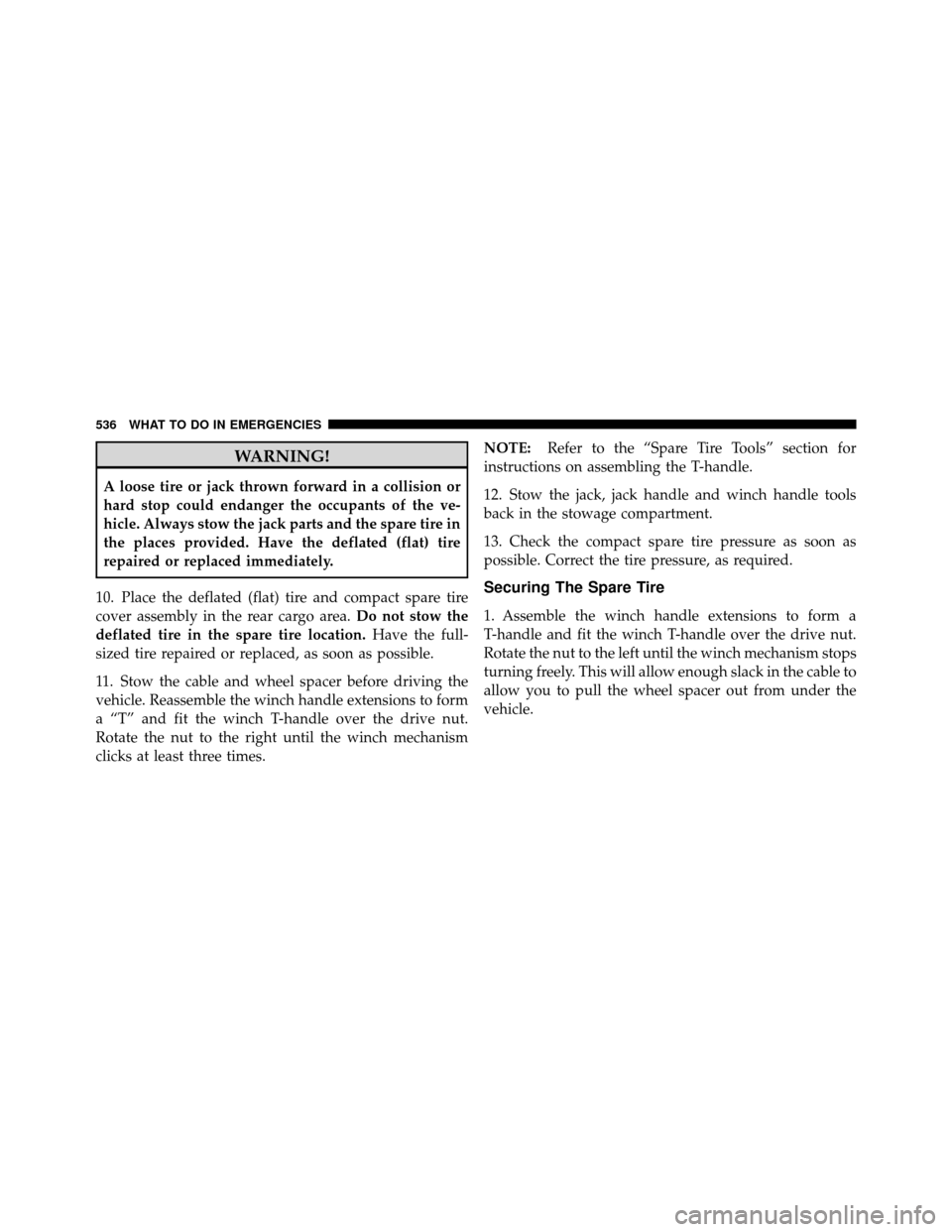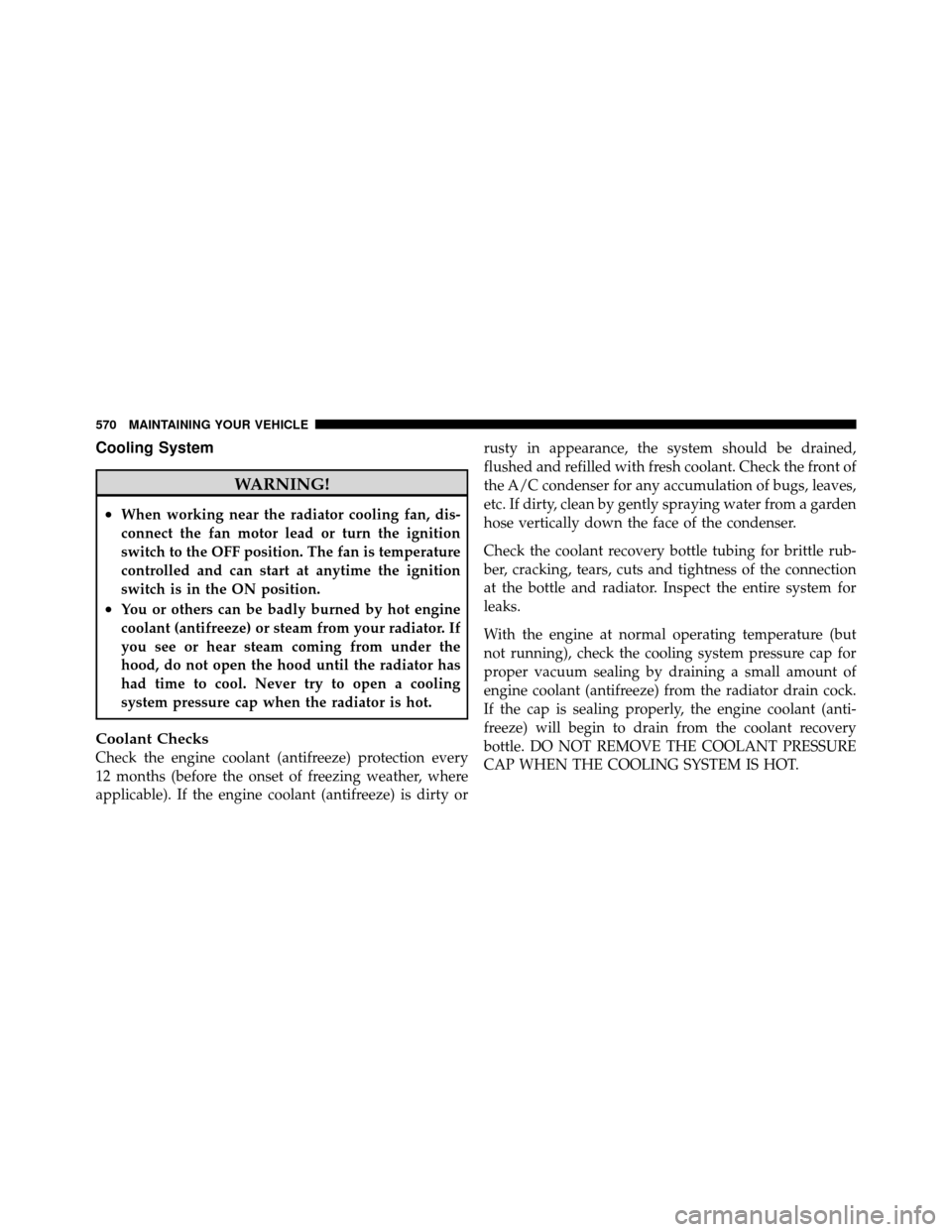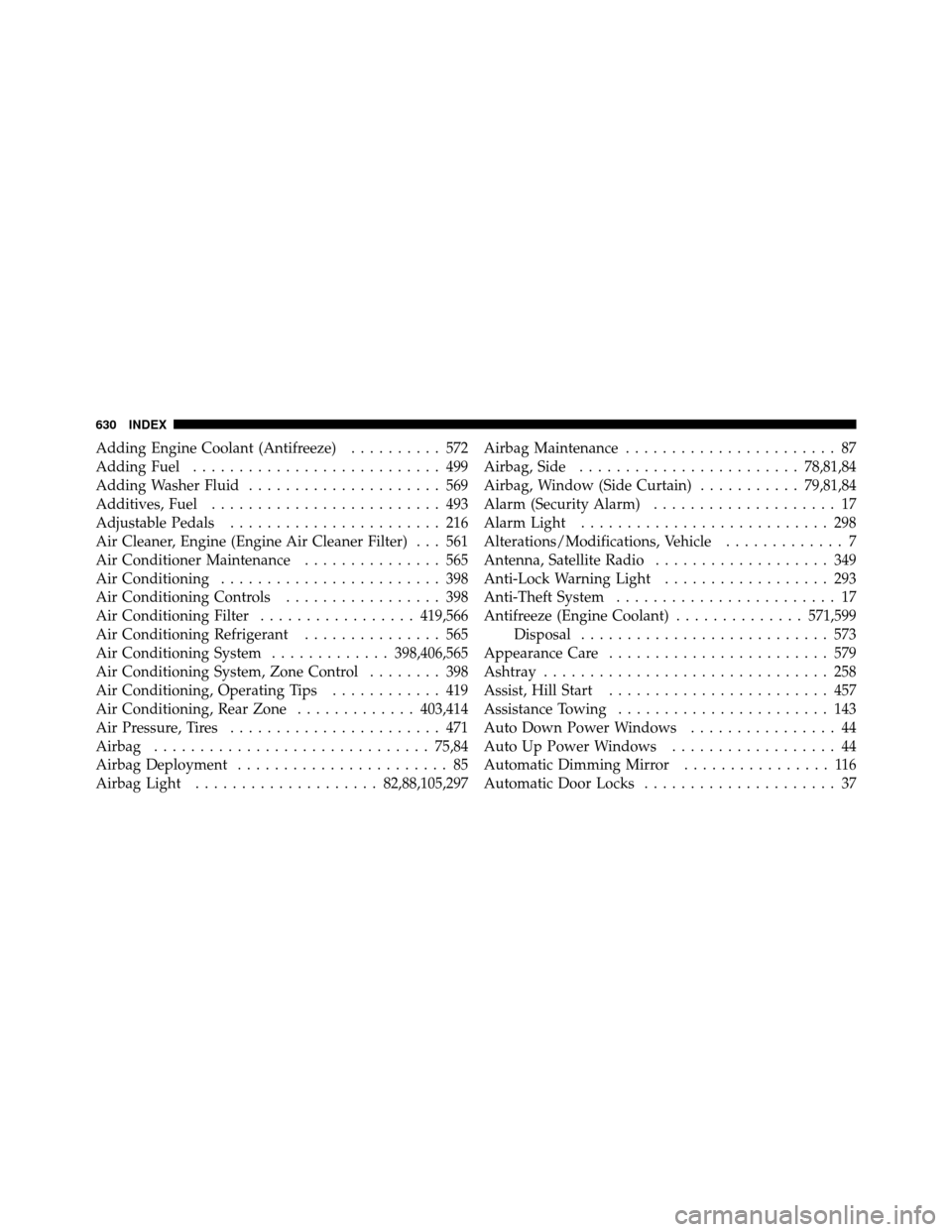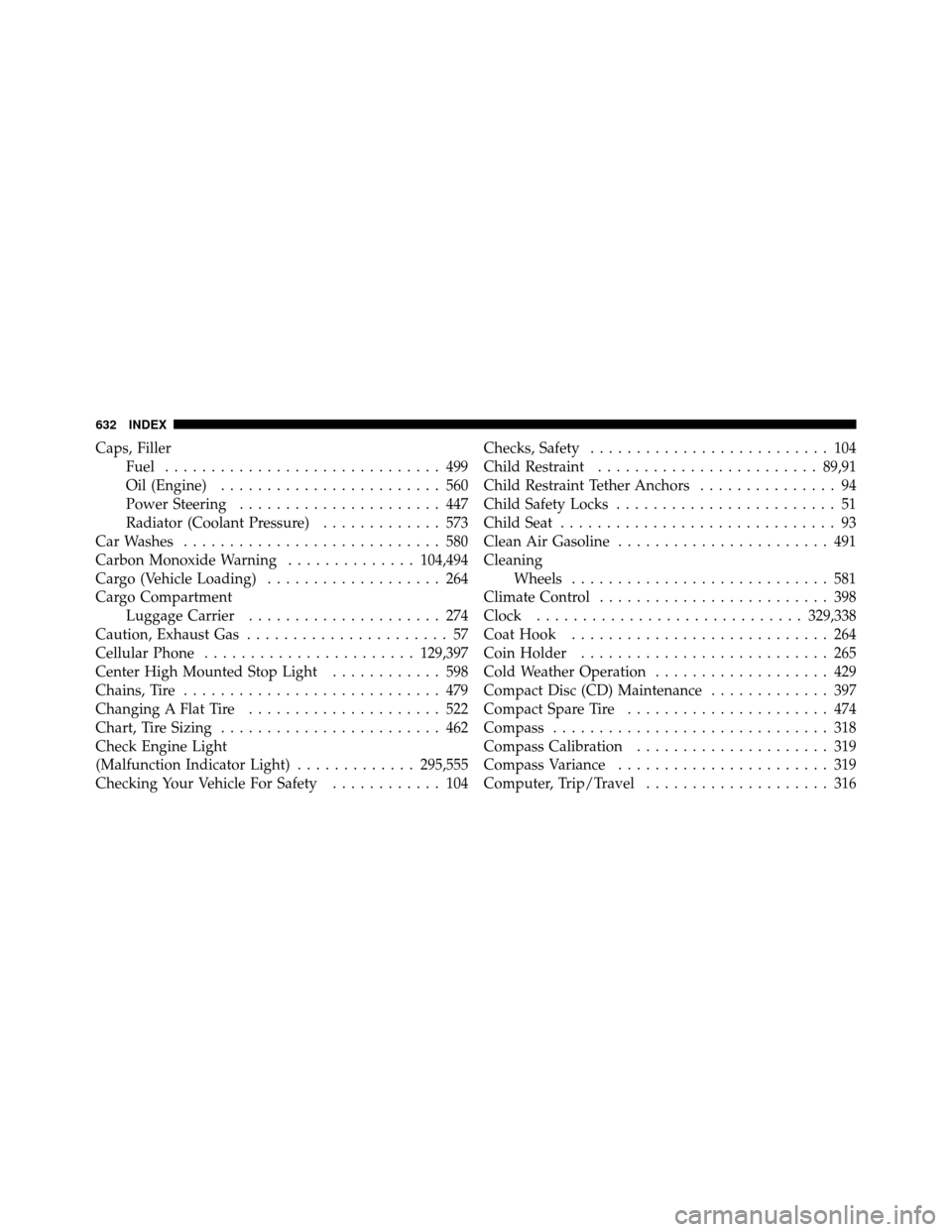2012 CHRYSLER TOWN AND COUNTRY tire pressure
[x] Cancel search: tire pressurePage 504 of 652

WARNING!
Because the front wheels drive and steer the vehicle,
it is important that you do not exceed the maximum
front or rear GAWR. A dangerous driving condition
can result if either rating is exceeded. You could lose
control of the vehicle and have a collision.
Tire Size
The tire size on the Vehicle Certification Label represents
the actual tire size on your vehicle. Replacement tires
must be equal to the load capacity of this tire size.
Rim Size
This is the rim size that is appropriate for the tire size
listed.
Inflation Pressure
This is the cold tire inflation pressure for your vehicle, for
all loading conditions up to full GAWR.
Curb Weight
The curb weight of a vehicle is defined as the total weight
of the vehicle with all fluids, including vehicle fuel, at full
capacity conditions, and with no occupants or cargo
loaded into the vehicle. The front and rear curb weight
values are determined by weighing your vehicle on a
commercial scale before any occupants or cargo are
added.
Overloading
The load carrying components (axle, springs, tires,
wheels, etc.) of your vehicle will provide satisfactory
service as long as you do not exceed the GVWR and front
and rear GAWR.
The best way to figure out the total weight of your
vehicle is to weigh it when it is fully loaded and ready for
operation. Weigh it on a commercial scale to ensure that
it is not over the GVWR.
502 STARTING AND OPERATING
Page 515 of 652

Towing Requirements – Tires
•
Do not attempt to tow a trailer while using a compact
spare tire.
•Proper tire inflation pressures are essential to the safe
and satisfactory operation of your vehicle. Refer to
“Tires – General Information” in “Starting and Oper-
ating” for proper tire inflation procedures.
•Check the trailer tires for proper tire inflation pres-
sures before trailer usage.
•Check for signs of tire wear or visible tire damage
before towing a trailer. Refer to “Tires – General
Information” in “Starting and Operating” for the
proper inspection procedure.
•When replacing tires, refer to “Tires – General Infor-
mation” in “Starting and Operating” for proper tirereplacement procedures. Replacing tires with a higher
load carrying capacity will not increase the vehicle’s
GVWR and GAWR limits.
Towing Requirements – Trailer Brakes
•
Do
not interconnect the hydraulic brake system or
vacuum system of your vehicle with that of the trailer.
This could cause inadequate braking and possible
personal injury.
•An electronically actuated trailer brake controller is
required when towing a trailer with electronically
actuated brakes. When towing a trailer equipped with
a hydraulic surge actuated brake system, an electronic
brake controller is not required.
•Trailer brakes are recommended for trailers over
1,000 lbs (454 kg) and required for trailers in excess of
2,000 lbs (907 kg).
5
STARTING AND OPERATING 513
Page 524 of 652

CAUTION!
Driving with a hot cooling system could damage
your vehicle. If temperature gauge reads “H”, pull
over and stop the vehicle. Idle the vehicle with the air
conditioner turned off until the pointer drops back
into the normal range. If the pointer remains on the
“H”, turn the engine off immediately, and call for
service.
WARNING!
You or others can be badly burned by hot engine
coolant (antifreeze) or steam from your radiator. If
you see or hear steam coming from under the hood,
do not open the hood until the radiator has had time
to cool. Never try to open a cooling system pressure
cap when the radiator or coolant bottle is hot.
JACKING AND TIRE CHANGING
WARNING!
•Do not attempt to change a tire on the side of the
vehicle close to moving traffic. Pull far enough off
the road to avoid the danger of being hit when
operating the jack or changing the wheel.
•Being under a jacked-up vehicle is dangerous. The
vehicle could slip off the jack and fall on you. You
could be crushed. Never put any part of your body
under a vehicle that is on a jack. If you need to get
under a raised vehicle, take it to a service center
where it can be raised on a lift.
•Never start or run the engine while the vehicle is
on a jack.(Continued)
522 WHAT TO DO IN EMERGENCIES
Page 538 of 652

WARNING!
A loose tire or jack thrown forward in a collision or
hard stop could endanger the occupants of the ve-
hicle. Always stow the jack parts and the spare tire in
the places provided. Have the deflated (flat) tire
repaired or replaced immediately.
10. Place the deflated (flat) tire and compact spare tire
cover assembly in the rear cargo area. Do not stow the
deflated tire in the spare tire location. Have the full-
sized tire repaired or replaced, as soon as possible.
11. Stow the cable and wheel spacer before driving the
vehicle. Reassemble the winch handle extensions to form
a “T” and fit the winch T-handle over the drive nut.
Rotate the nut to the right until the winch mechanism
clicks at least three times. NOTE:
Refer to the “Spare Tire Tools” section for
instructions on assembling the T-handle.
12. Stow the jack, jack handle and winch handle tools
back in the stowage compartment.
13. Check the compact spare tire pressure as soon as
possible. Correct the tire pressure, as required.
Securing The Spare Tire
1. Assemble the winch handle extensions to form a
T-handle and fit the winch T-handle over the drive nut.
Rotate the nut to the left until the winch mechanism stops
turning freely. This will allow enough slack in the cable to
allow you to pull the wheel spacer out from under the
vehicle.
536 WHAT TO DO IN EMERGENCIES
Page 572 of 652

Cooling System
WARNING!
•When working near the radiator cooling fan, dis-
connect the fan motor lead or turn the ignition
switch to the OFF position. The fan is temperature
controlled and can start at anytime the ignition
switch is in the ON position.
•You or others can be badly burned by hot engine
coolant (antifreeze) or steam from your radiator. If
you see or hear steam coming from under the
hood, do not open the hood until the radiator has
had time to cool. Never try to open a cooling
system pressure cap when the radiator is hot.
Coolant Checks
Check the engine coolant (antifreeze) protection every
12 months (before the onset of freezing weather, where
applicable). If the engine coolant (antifreeze) is dirty orrusty in appearance, the system should be drained,
flushed and refilled with fresh coolant. Check the front of
the A/C condenser for any accumulation of bugs, leaves,
etc. If dirty, clean by gently spraying water from a garden
hose vertically down the face of the condenser.
Check the coolant recovery bottle tubing for brittle rub-
ber, cracking, tears, cuts and tightness of the connection
at the bottle and radiator. Inspect the entire system for
leaks.
With the engine at normal operating temperature (but
not running), check the cooling system pressure cap for
proper vacuum sealing by draining a small amount of
engine coolant (antifreeze) from the radiator drain cock.
If the cap is sealing properly, the engine coolant (anti-
freeze) will begin to drain from the coolant recovery
bottle. DO NOT REMOVE THE COOLANT PRESSURE
CAP WHEN THE COOLING SYSTEM IS HOT.
570 MAINTAINING YOUR VEHICLE
Page 608 of 652

Once A Month
•Check tire pressure and look for unusual wear or
damage.
•Inspect the battery and clean and tighten the terminals
as required.
•Check the fluid levels of the coolant reservoir, brake
master cylinder, and the power steering and add as
needed.
•Check all lights and other electrical items for correct
operation.At Each Oil Change
•Change the engine oil filter.
•Inspect the brake hoses and lines.
•Open the left and right door (slowly) and inspect for
excessive dirt. If noise exist wipe clean and apply
krytox lube to the door rollers.
CAUTION!
Failure to perform the required maintenance items
may result in damage to the vehicle.
Required Maintenance Intervals
Refer to the Maintenance Schedules on the following
pages for the required maintenance intervals.8
M
A I
N T
E
N A
N CE
S
C
H E
D
U L
E
S606 MAINTENANCE SCHEDULES
Page 632 of 652

Adding Engine Coolant (Antifreeze).......... 572
Adding Fuel ........................... 499
Adding Washer Fluid ..................... 569
Additives, Fuel ......................... 493
Adjustable Pedals ....................... 216
Air Cleaner, Engine (Engine Air Cleaner Filter) . . . 561
Air Conditioner Maintenance ............... 565
Air Conditioning ........................ 398
Air Conditioning Controls ................. 398
Air Conditioning Filter .................419,566
Air Conditioning Refrigerant ............... 565
Air Conditioning System .............398,406,565
Air Conditioning System, Zone Control ........ 398
Air Conditioning, Operating Tips ............ 419
Air Conditioning, Rear Zone .............403,414
Air Pressure, Tires ....................... 471
Airbag .............................. 75,84
Airbag Deployment ....................... 85
Airbag Light .................... 82,88,105,297Airbag Maintenance
....................... 87
Airbag, Side ........................ 78,81,84
Airbag, Window (Side Curtain) ...........79,81,84
Alarm (Security Alarm) .................... 17
Alarm Light ........................... 298
Alterations/Modifications, Vehicle ............. 7
Antenna, Satellite Radio ................... 349
Anti-Lock Warning Light .................. 293
Anti-Theft System ........................ 17
Antifreeze (Engine Coolant) ..............571,599
Disposal ........................... 573
Appearance Care ........................ 579
Ashtray ............................... 258
Assist, Hill Start ........................ 457
Assistance Towing ....................... 143
Auto Down Power Windows ................ 44
Auto Up Power Windows .................. 44
Automatic Dimming Mirror ................ 116
Automatic Door Locks ..................... 37
630 INDEX
Page 634 of 652

Caps, FillerFuel .............................. 499
Oil (Engine) ........................ 560
Power Steering ...................... 447
Radiator (Coolant Pressure) ............. 573
Car Washes ............................ 580
Carbon Monoxide Warning ..............104,494
Cargo (Vehicle Loading) ................... 264
Cargo Compartment Luggage Carrier ..................... 274
Caution, Exhaust Gas ...................... 57
Cellular Phone ....................... 129,397
Center High Mounted Stop Light ............ 598
Chains, Tire ............................ 479
Changing A Flat Tire ..................... 522
Chart, Tire Sizing ........................ 462
Check Engine Light
(Malfunction Indicator Light) .............295,555
Checking Your Vehicle For Safety ............ 104Checks, Safety
.......................... 104
Child Restraint ........................ 89,91
Child Restraint Tether Anchors ............... 94
Child Safety Locks ........................ 51
Child Seat .............................. 93
Clean Air Gasoline ....................... 491
Cleaning Wheels ............................ 581
Climate Control ......................... 398
Clock ............................. 329,338
Coat Hook ............................ 264
Coin Holder ........................... 265
Cold Weather Operation ................... 429
Compact Disc (CD) Maintenance ............. 397
Compact Spare Tire ...................... 474
Compass .............................. 318
Compass Calibration ..................... 319
Compass Variance ....................... 319
Computer, Trip/Travel .................... 316
632 INDEX